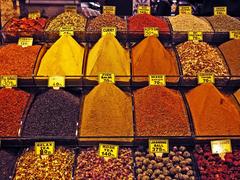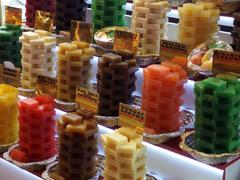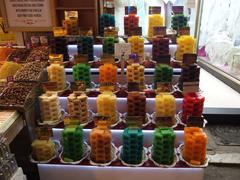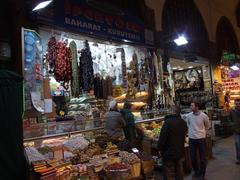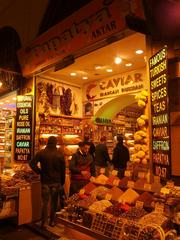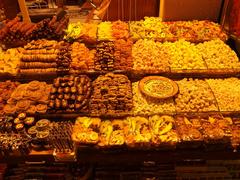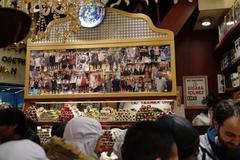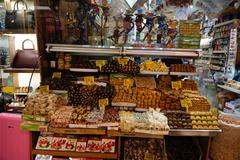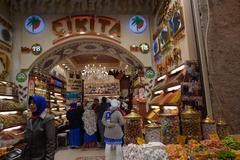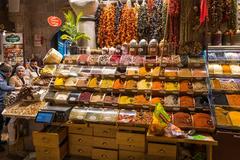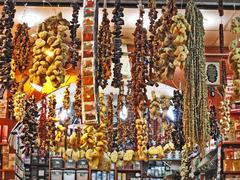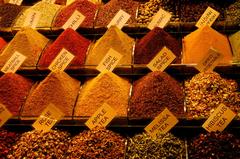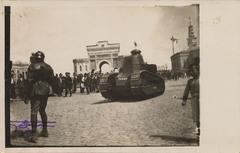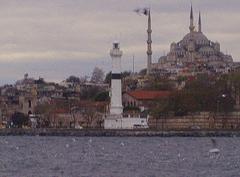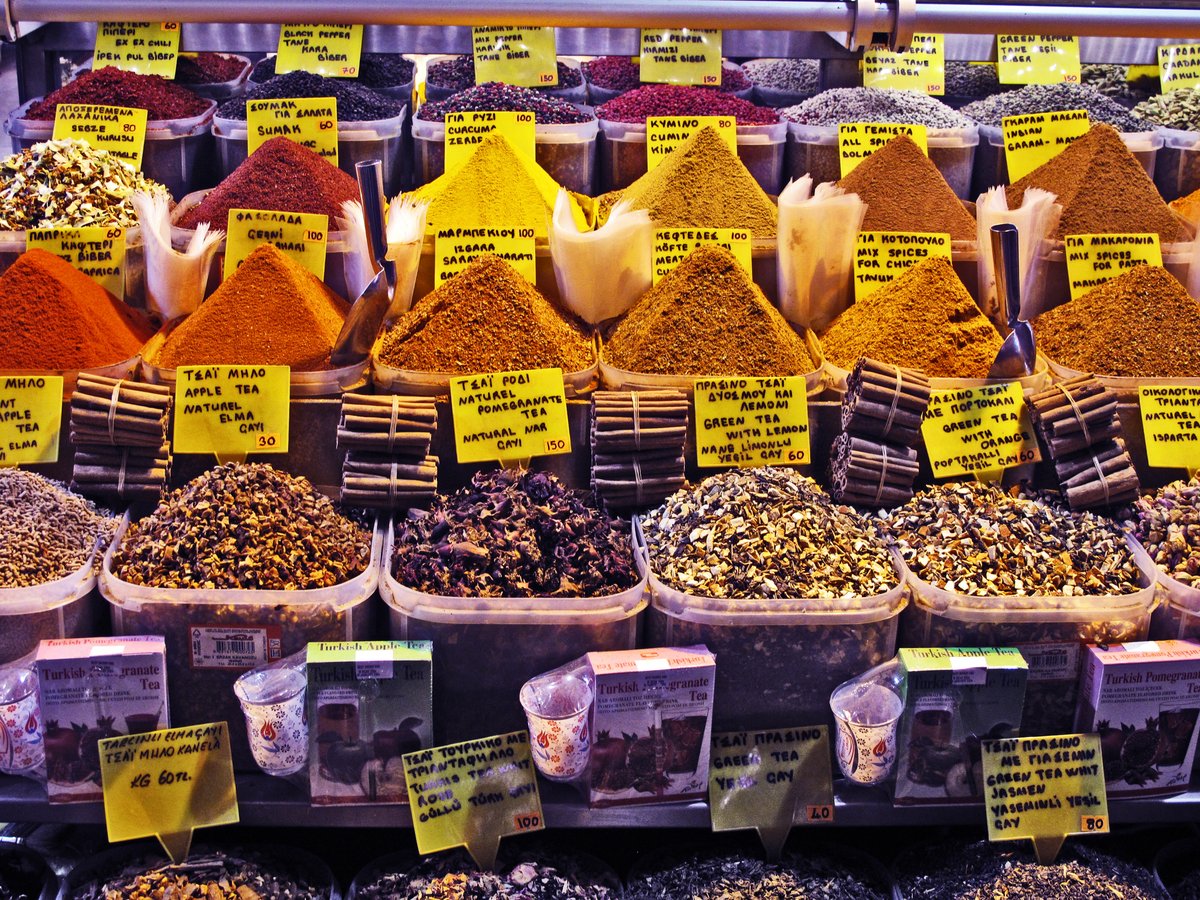
A Comprehensive Guide to Visiting Mısır Çarşısı, Istanbul, Türkiye: History, Significance, and Visitor Tips
Date: 16/07/2024
Introduction
The Spice Bazaar, known locally as Mısır Çarşısı or the Egyptian Bazaar, stands as one of Istanbul’s most captivating historical sites. Nestled in the heart of the city, this vibrant marketplace offers more than just a sensory feast of spices, sweets, and exotic goods. It also serves as a living monument to Istanbul’s rich Ottoman heritage, drawing visitors from around the world to experience its unique blend of history, culture, and commerce (istanbul.com). Constructed in the 17th century as an extension of the Yeni Cami (New Mosque) complex, the bazaar was funded by taxes levied on goods imported from Egypt, hence its name (discoverwalks.com). The Spice Bazaar has evolved over centuries, surviving fires and economic shifts, yet it remains a bustling hub of activity and a testament to the resilience and enduring spirit of Istanbul (urbstravel.com). This guide aims to provide a comprehensive overview of the Spice Bazaar’s history, architectural splendor, and practical visitor information, ensuring a fulfilling and immersive experience for all who visit.
Table of Contents
- Introduction
- History and Significance
- Architectural Splendor
- Practical Information
- The Spice Bazaar Today
- Visitor Tips and Essential Information
- Frequently Asked Questions (FAQ)
- Conclusion
History and Significance
Origins as an Imperial Project
The Spice Bazaar’s construction was ordered as an extension of the magnificent Yeni Cami (New Mosque) complex. This ambitious project, initiated in 1597 by Safiye Sultan (mother of Sultan Mehmed III), aimed to create a social and religious hub in the heart of Istanbul. However, the complex’s completion was overseen by another powerful woman, Valide Sultan Turhan Hatice, mother of Sultan Mehmed IV, showcasing the influence of these women in Ottoman society (discoverwalks.com).
Funding and the Egyptian Connection
The Spice Bazaar’s construction was completed in 1664, financed by taxes levied on goods imported from Egypt. This funding method is reflected in the bazaar’s name, Mısır Çarşısı, with “Mısır” meaning both “Egypt” and “maize” in Turkish. This dual meaning has led to some mistranslations, but the connection to Egypt remains strong (urbstravel.com).
A Legacy of Trade and Resilience
The Spice Bazaar quickly became a vibrant center of commerce, with its 88 vaulted rooms housing merchants selling spices, herbs, dried fruits, nuts, and other delicacies. The aroma of exotic spices filled the air, attracting locals and travelers alike. The bazaar’s revenue played a crucial role in supporting the upkeep of the New Mosque and its associated institutions, including a school, a hospital, and public baths (istanbulpoints.com). Throughout its history, the Spice Bazaar has witnessed periods of both prosperity and hardship. The Great Fire of 1660, which devastated much of Istanbul, also impacted the bazaar. However, like the city itself, the bazaar rose from the ashes, its reconstruction a testament to its importance and resilience (discoverwalks.com).
Architectural Splendor
Design and Layout
The bazaar’s distinctive L-shape, a common feature in Ottoman architecture, optimizes space and allows for a seamless flow of visitors. This design creates a network of interconnected vaulted corridors, each brimming with vibrant stalls and enticing aromas (istanbeautiful.com). The bazaar comprises 88 domed chambers, each meticulously crafted to create a sense of grandeur and spaciousness. These domes, a hallmark of Islamic architecture, not only enhance the aesthetic appeal but also provide natural light and ventilation (istanbeautiful.com). Six imposing gates, strategically positioned around the perimeter, welcome visitors into the bustling marketplace. Each gate, adorned with intricate carvings and calligraphy, offers a glimpse into the architectural richness that awaits within (istanbeautiful.com).
Notable Architectural Elements
Among the six gates, the Haseki Gate stands out with its two-story structure, a testament to the bazaar’s former administrative role. The upper floor, once a court for resolving merchant disputes, showcases the bazaar’s historical significance beyond commerce (istanbeautiful.com). The bazaar’s vaulted ceilings, adorned with intricate brickwork and geometric patterns, create a sense of awe and wonder. These architectural marvels not only enhance the aesthetic appeal but also provide structural support and acoustic balance (travelstoreturkey.com). Strategically placed openings in the vaulted ceilings allow natural light to filter through, illuminating the vibrant colors and textures of the marketplace. This interplay of light and shadow creates a dynamic and inviting atmosphere (travelstoreturkey.com).
Practical Information
Visiting Hours and Tickets
The Spice Bazaar is open daily from 9:00 AM to 7:00 PM, with slightly shorter hours on Sundays and public holidays. Admission to the bazaar is free, but it’s recommended to carry cash for purchases as not all vendors accept credit cards.
Travel Tips
- Best Time to Visit: Early mornings or late afternoons are ideal to avoid the crowds.
- Getting There: The bazaar is easily accessible by public transport. The nearest tram stop is Eminönü.
- Bargaining: Haggling is common, so don’t be afraid to negotiate prices.
Nearby Attractions
- Yeni Cami (New Mosque): Located adjacent to the bazaar, this mosque is a must-visit for its stunning architecture.
- Galata Bridge: A short walk from the bazaar, offering beautiful views of the Golden Horn.
- Grand Bazaar: Another famous Istanbul market, just a tram ride away.
The Spice Bazaar Today
Special Events and Guided Tours
The Spice Bazaar hosts various events throughout the year, including culinary tours and cultural festivals. Guided tours are available for those who wish to delve deeper into the bazaar’s history and its offerings (tripoto.com).
Visitor Tips and Essential Information
Best Time to Visit
- Weekdays over Weekends: Like most popular attractions, the Spice Bazaar sees a surge in visitors during weekends. Opting for a weekday visit, especially in the morning, will offer a more relaxed and enjoyable experience (avoid-crowds.com).
- Mornings for Freshness: Vendors typically restock their stalls in the morning, offering the freshest produce and a wider selection (istanbeautiful.com).
- Evenings for Ambiance: While potentially more crowded, the bazaar takes on a magical ambiance in the evening, with the soft glow of lights illuminating the colorful displays.
Getting Around
- Embrace the Labyrinth: The Spice Bazaar is best explored by simply wandering through its maze-like alleys. Don’t be afraid to get lost – you’re bound to stumble upon hidden gems and unique finds.
- Take Your Time: Don’t rush your visit. Allow ample time to browse the stalls, interact with vendors, and soak in the vibrant atmosphere.
- Dress Comfortably: Wear comfortable shoes as you’ll be doing a fair amount of walking.
Shopping Smart
- Cash is King: While some vendors might accept credit cards, it’s always advisable to carry Turkish Lira, especially for smaller purchases and bargaining (istanbul.tips).
- The Art of Bargaining: Bargaining is an integral part of the bazaar experience. Don’t hesitate to negotiate prices, but always be respectful and good-natured. A smile and friendly banter can go a long way (travelstoreturkey.com).
- Sample Before You Buy: Many vendors offer samples of their wares, allowing you to taste and experience the products before making a purchase.
- Quality over Quantity: Focus on purchasing a few high-quality items rather than a large quantity of souvenirs.
Sensory Delights
- Engage Your Senses: The Spice Bazaar is a feast for the senses. Breathe in the intoxicating aromas of spices, admire the vibrant colors of Turkish delight, and savor the flavors of traditional treats.
- Turkish Delight Heaven: Indulge in the sweet temptation of Turkish delight (lokum), available in a myriad of flavors and colors.
- Spice Up Your Life: Discover a world of spices, from the familiar cumin and turmeric to the more exotic sumac and mahlep (travelstoreturkey.com).
- Coffee Break: Take a break from shopping and enjoy a cup of traditional Turkish coffee at one of the cafes or coffee stalls.
Safety and Etiquette
- Be Aware of Surroundings: As with any crowded place, be mindful of your belongings and surroundings.
- Respectful Photography: While capturing the vibrant scenes is tempting, always ask for permission before photographing vendors or their stalls.
- Dress Modestly: While there’s no strict dress code, remember that the Spice Bazaar is located near the New Mosque, a religious site. Dressing modestly is a sign of respect.
Beyond the Bazaar
- Explore the Surroundings: The Spice Bazaar is located in the Eminönü district, a bustling hub with other attractions like the New Mosque, the Galata Bridge, and the Bosphorus Strait.
- Combine with Other Attractions: Consider combining your visit with a cruise on the Bosphorus or a stroll across the Galata Bridge for a complete Istanbul experience (tripoto.com).
Frequently Asked Questions (FAQ)
- Q: What are the Spice Bazaar visiting hours?
- A: The bazaar is open daily from 9:00 AM to 7:00 PM, with shorter hours on Sundays and public holidays.
- Q: Do I need to buy a ticket to enter the Spice Bazaar?
- A: No, there is no entry fee to visit the Spice Bazaar.
- Q: Is the Spice Bazaar wheelchair accessible?
- A: Yes, the bazaar is wheelchair accessible, although the cobblestone streets may be challenging.
Conclusion
The Spice Bazaar is not just a place to shop; it’s a place to experience the soul of Istanbul. It’s where history comes alive, and the scents and sounds of centuries past mingle with the energy of the present. A visit to the Spice Bazaar is a journey through time, a sensory feast, and an unforgettable experience that captures the essence of this magical city. For a truly enriching experience, plan your visit with the practical tips provided in this guide and immerse yourself in the history, culture, and vibrancy of one of Istanbul’s most iconic landmarks (istanbeautiful.com).
References
- Discovering the Spice Bazaar - Visiting Hours, Tickets, and Historical Insights. (n.d.). Istanbul.com. Retrieved from https://istanbul.com/about-city/the-spice-bazaar
- 10 Interesting Facts About Mısır Çarşısı. (n.d.). Discover Walks. Retrieved from https://www.discoverwalks.com/blog/istanbul/10-interesting-facts-about-misir-carsisi
- History of the Spice Bazaar. (n.d.). Urbstravel. Retrieved from https://www.urbstravel.com/post/history-of-the-spice-bazaar
- Spice Bazaar Istanbul. (n.d.). Travelstoreturkey. Retrieved from https://www.travelstoreturkey.com/spice-bazaar-istanbul/
- Exploring the Architectural Splendor of Mısır Çarşısı. (n.d.). Istanbulbeautiful. Retrieved from https://istanbeautiful.com/egyptian-spice-bazaar-istanbul/

